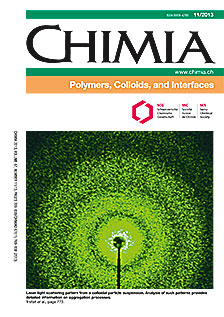Combining Polymers with the Functionality of Proteins: New Concepts for Atom Transfer Radical Polymerization, Nanoreactors and Damage Self-reporting Materials
DOI:
https://doi.org/10.2533/chimia.2013.777Keywords:
Biotransformations, Enzyme-catalyzed atom transfer radical polymerization, Mechanoresponsive materials, Nanoreactors, Polymer–protein hybrid materialsAbstract
Proteins are macromolecules with a great diversity of functions. By combining these biomolecules with polymers, exciting opportunities for new concepts in polymer sciences arise. This highlight exemplifies the aforementioned with current research results of our group. We review our discovery that the proteins horseradish peroxidase and hemoglobin possess ATRPase activity, i.e. they catalyze atom transfer radical polymerizations. Moreover, a permeabilization method for polymersomes is presented, where the photo-reaction of an ?-hydroxyalkylphenone with block copolymer vesicles yields enzyme-containing nanoreactors. A further intriguing possibility to obtain functional nanoreactors is to enclose a polymerization catalyst into the thermosome, a protein cage from the family of chaperonins. Last but not least, fluorescent proteins are discussed as mechanoresponsive molecular sensors that report microdamages within fiber-reinforced composite materials.Downloads
Published
2013-11-27
Issue
Section
Scientific Articles
License
Copyright (c) 2013 Swiss Chemical Society

This work is licensed under a Creative Commons Attribution-NonCommercial 4.0 International License.
How to Cite
[1]
Chimia 2013, 67, 777, DOI: 10.2533/chimia.2013.777.







